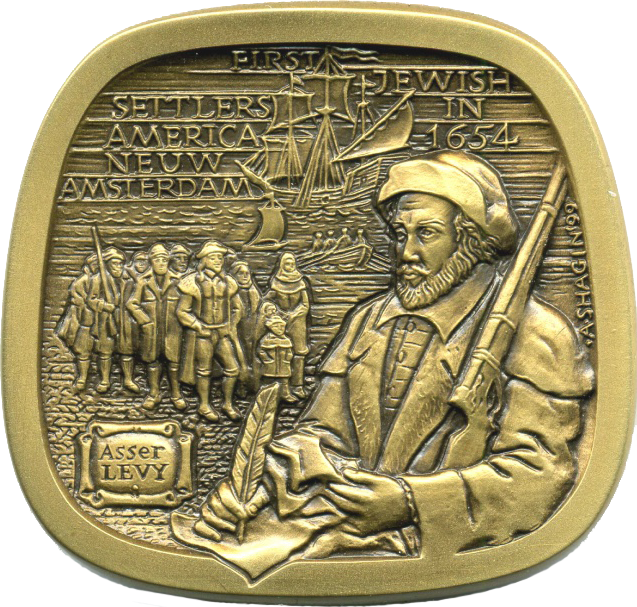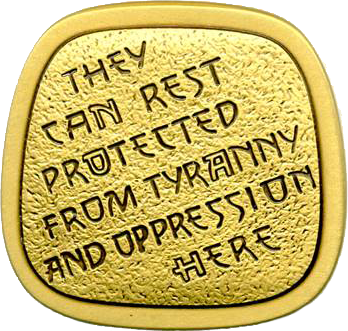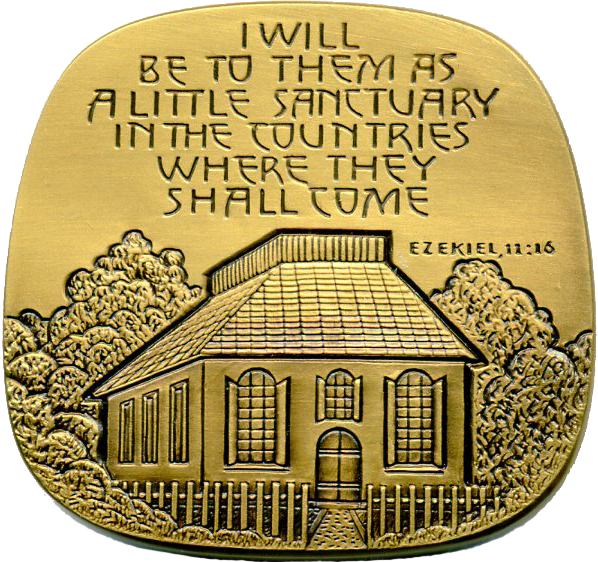 |  |
ASSER LEVY (?-1682) AND THE FIRST JEWISH SETTLERS IN AMERICA (1654)
Upper half of 2-part medal with obverse designed by Alex Shagin and reverse by Mel Wacks. Struck by Medalcraft Mint in quantities of 150 bronze and 65 pure silver; plus 14 cast in 10kt gold. Note that the struck medals fit precisely together, while the cast gold medal is a single piece with Levy on obverse and “THEY CAN REST …” on the reverse.
Obverse: Asser Levy in foreground, Jewish immigrants arriving from St. Catherine ship,
ASSER LEVY, FIRST JEWISH SETTLERS IN AMERICA 1654 NEUW AMSTERDAM, •A•SHAGIN 1999.
Reverse: THEY CAN REST PROTECTED FROM TYRANNY AND OPPRESSION HERE. 49 x 47 mm.
 |  |
Lower half of 2-part medal designed by Alex Shagin. Struck by Medalcraft Mint in quantities of 150 bronze and 65 pure silver; plus 14 cast in 10kt gold. Obverse: Mill Street Synagogue, I WILL BE TO THEM AS A LITTLE SANCTUARY IN THE COUNTRIES WHERE THEY SHALL COME, EZEKIAL 11:16.
Reverse: Interior of Crosby Street Synagogue. 49 x 47 mm.
Asser Levy was born in Poland, and later travelled to Amsterdam, where he learned about new opportunities in New Amsterdam. Together with two other Ashkenazi Jews, Jacob Barsimon and Solomon Pietersen, he sailed to Manhattan on board the “Peereboom,” (Pear Tree) on August 22, 1654. Within two weeks of Levy’s arrival, twenty three Sephardic Jews (four couples, two widows, and thirteen children). came to New Amsterdam aboard the St. Catherine, having fled Recife, the Dutch colony in Brazil which was recently lost to the Portuguese, who it was feared would bring the Inquisition with them.
Jews were initially denied the distinction of serving in the militia because of the “disinclination and unwillingness of fellow soldiers to be on guard with said nation.” Instead, Jews were required to pay an insulting tax. Asser Levy, one of the first Jewish settlers, fought and won the right to participate in the citizens’ guards in November 1655. After Levy also won the right to carry on trade in the community, he built a prosperous business in real estate and opened a Kosher butcher shop — becoming one of the most prominent New Yorkers of the 17th century.
Probably in deference to Stuyvesant, the Jews were not permitted to build a synagogue. However, this situation changed after the surrender of New Amsterdam to the British in 1664. While there is some evidence that services were held in a private home as early as 1695, the first congregation — Shearith Israel — was organized around 1706. Circa 1730, they erected a small synagogue on Mill Lane, which is pictured on this medal. At this time there were only about 30 Jewish households in New York City.
The synagogue was expanded and rededicated in 1818, when Mordecai Manuel Noah delivered a speech in which he proclaimed that “Until the Jews can recover their ancient rights and dominions, and take their rank among the governments of the earth, this is their chosen country; here they can rest with the persecuted from every clime, protected from tyranny and oppression, and participating of equal rights and immunities.” An excerpt from this speech is featured on this medal, with the encrypted name of “NOAH.”
When the congregation outgrew its Mill Lane building, they moved uptown and built a new synagogue on Crosby Street, which they occupied from 1834 to 1860; its interior is shown on this medal. Historic remnants of the first synagogue can still be seen in Shearith Israel’s current building on West 70th Street.